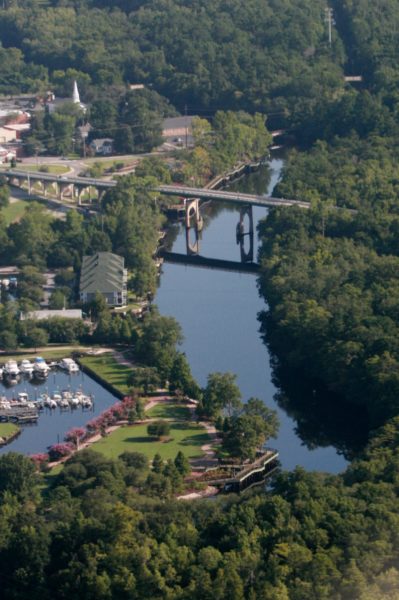Like many white, middle-class, suburban kids, I grew up with one foot in the forest. To me, that small woodlot, a green buffer along a half-polluted tributary, was a paradise unmatched by any other forest in the world. Unfortunately, like many other tracts of land across the United States, my childhood forest is gone—cleared for a housing development.

Wetlands, including wetland forests, are the “filters” of our natural system, combating pollution, removing excess nutrients, and securing fresh drinking water for surrounding and downstream communities. Photo credit: Dogwood Alliance.
Wetland forests offer massive economic benefits
Even small forests across the United States work to provide “ecosystem services”—non-monetary benefits like clean water, clean air, carbon sequestration, hunting, fishing, and yes—recreation for children. Ecosystem services may sound like “lip service” to the natural world, but it’s not. New York city chose to spend $500 million to protect and preserve its upstream watershed (and resulting water quality), to avoid the $3-5 billion price tag of a new water supply system on the Hudson river. Forests in the U.S. offset about 13% of our yearly carbon emissions. In 2002, southern forests supported over a million jobs in the recreation/tourism sectors, generating $19-76 billion dollars in annual revenue. All of these services require healthy, standing forests across the landscape.
As our country continues to grow, we are increasing the pressures on our forests. We need clean air and clean water, but we also need wood products, food, and housing. As Research Manager at Dogwood Alliance, I work every day with other organizations and communities to improve the quality and quantity of southern forests. Much of my day-to-day is focused on coordinating and organizing a new initiative, the Wetland Forest Initiative, to conserve, restore, and improve southern wetland forests.

Cypress-tupelo forests, also known as bottomland hardwood forests, can occasionally have trees live for over a thousand years. Photo credit: Dogwood Alliance
Wetland forests are the best of both worlds. You can visit during a dry season to walk beside ancient trees, or explore during the wet season by kayaking in submerged habitat, teeming with aquatic invertebrates, migratory birds, fish, reptiles, and amphibians. “Wetland forest” describes so much of the American landscape—from forests edging creeks and the culturally treasured bayous; to coastally influenced forests, which somehow survive the onslaught of the ocean. Wetland forests span 35 million acres across 14 southern states, and provide twice the ecosystem services value of upland forests.
Taking action to save our wetlands
Yet, with a majority of wetland forests lost—cleared for agriculture, drained for commercial or residential development, even cut and converted to fast-growing commercial pine plantations—we are at a fork in the road. Will we allow our wetland forests to dwindle to less than one percent of their original range, like we did with longleaf pine? Or will we take action now to conserve these vital ecosystems, before it’s too late?

Wetland forests are home to many endemic species, found nowhere else on earth. This photo was taken during a flyover search for the swallow-tailed kite, a bird native to southern wetland forests. Photo credit: Maria Whitehead
The Wetland Forest Initiative is working to conserve, restore, and improve these habitats. In special places, we will work to protect the legacy of rare, threatened, and endangered species, ensuring that they will have habitat for decades to come. In places where wetland forests have been degraded by lack of management, changes in hydrology, or pollution, we will work with local groups and governments to restore the land to ecological function. Beyond the tree line, we will work with politicians and government agencies to ensure that landowners are awarded with fair compensation for their restoration and conservation efforts. And perhaps most importantly, we will work with communities, to educate them about the beauty and importance of what’s happening on the ground in their local wetland forests.
Although I never thought I would leave academia, I am happy to spend my working hours on a project that has the potential to impact 35 million acres across 14 states. Despite the differences in opinion that some of our member organizations may have, it is inspiring to see so many people from different walks of life (academic, community, environment, forestry, government, land management, landowners, social justice, and tribal) come together and create meaningful change. I am excited for the future of our southern wetland forests.
I encourage you to head over to the Wetland Forest Initiative website to learn more, endorse the platform, and get your organization or university involved.
